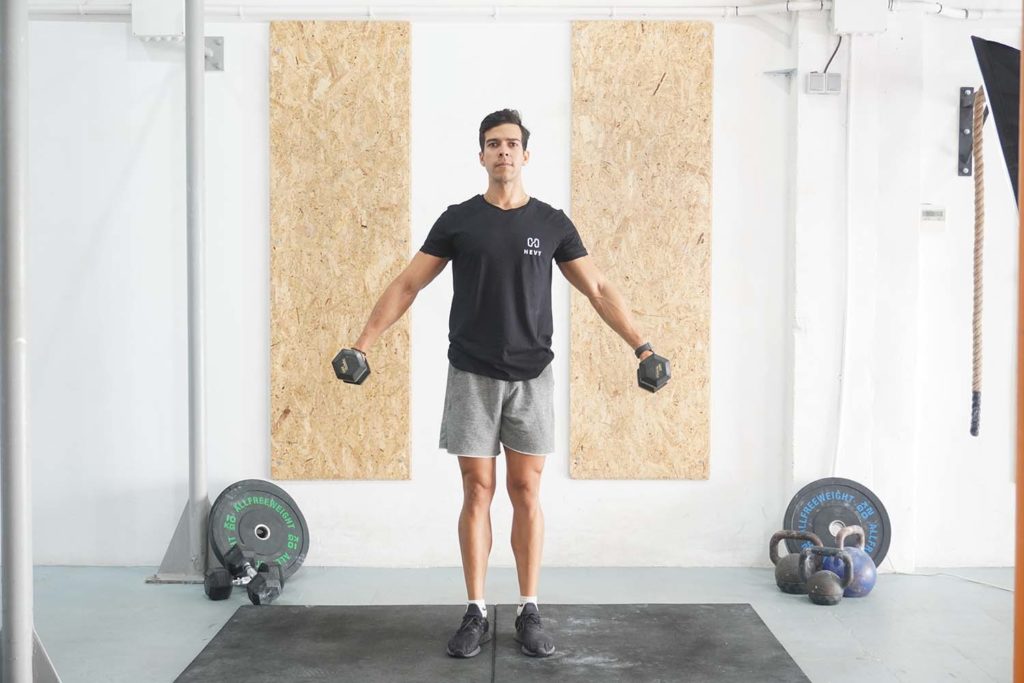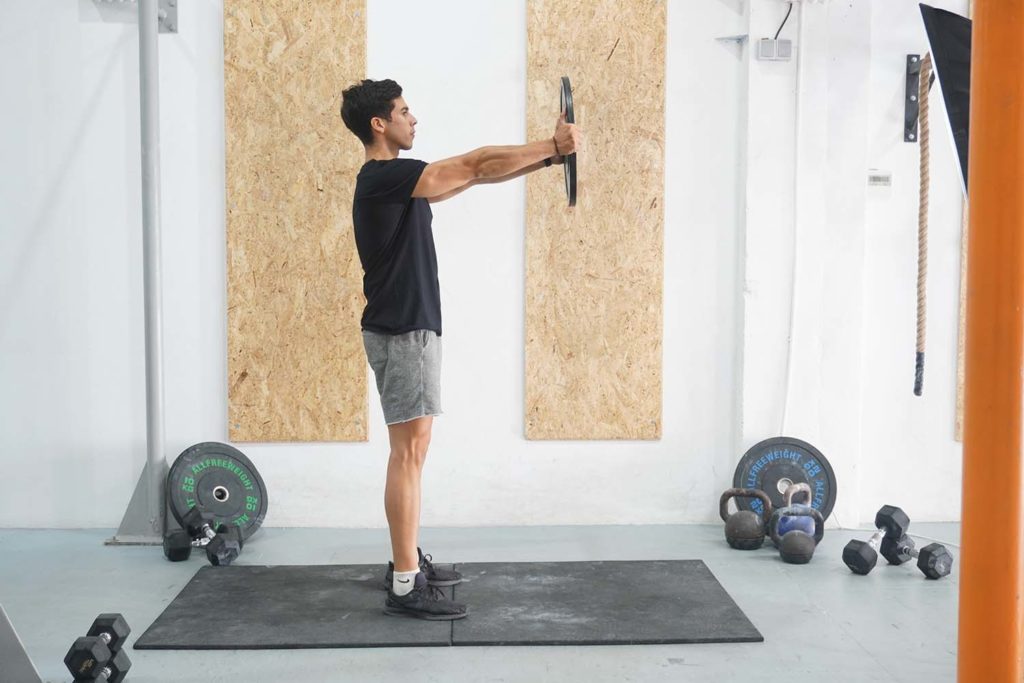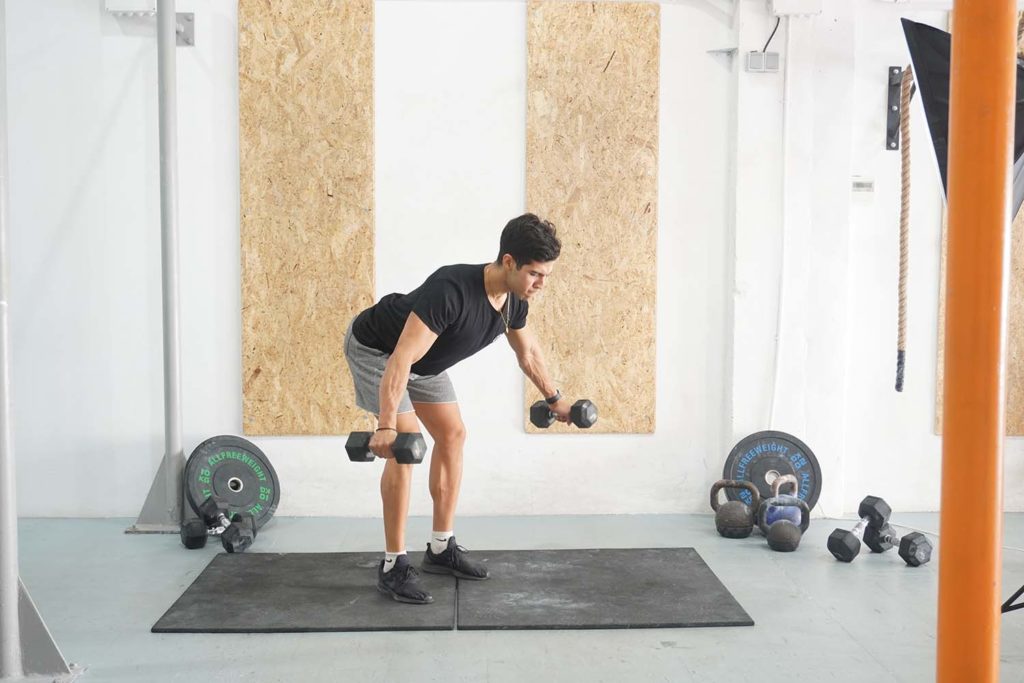Why are dumbbell lateral raises essential in the development of toned shoulders?
If you’re interested in building a set of round shoulders, overhead pressing alone won’t be enough. Your shoulders are relatively small muscles, but this doesn’t mean they are simple to grow and strengthen. The shoulder consists of three heads: the front (anterior), middle (lateral), and rear (posterior) (1). Each area needs adequate stimulation to grow optimally, resulting in a set of strong, functional, and muscular shoulders.
Dumbbell lateral raises are an isolation exercise that trains the entire shoulder but primarily activates the middle deltoid head. Doing lateral raises is beneficial for improving the overall appearance of the shoulder and making it stronger.
Strong shoulders might not seem that important, but the muscle group envelops the mobile and injury-prone shoulder joint. Having strong deltoids leads to better stability of the shoulder and a reduced risk of training or sports-related injuries. Plus, our shoulders play an essential role in many activities, especially when raising something over your head.
How to do Dumbbell Lateral Raises
- Grab a pair of dumbbells that are light enough for you to do at least twelve repetitions per set.
- Stand tall with the dumbbells to your sides and palms facing in.
- Bring your shoulders back, direct your gaze forward, and take a breath. Make sure that both of your arms are straight.
- Raise both dumbbells to your sides by engaging your delts and lift them to the point where your arms are parallel to the floor. Don’t bend your elbow at any point during the lift.
- Hold the top position for a second as you exhale, and slowly lower both of your arms to the starting position.
- It’s essential to perform each repetition with a smooth form and without the use of momentum.
What muscles do dumbbell lateral raises activate?
As an isolation exercise, dumbbell lateral raises target our deltoids – the rounded muscles on our upper arms. As briefly mentioned above, our deltoids have three heads: the front, middle, and rear. Each head has unique functions, but all three contribute to arm abduction (moving your arm away from the midline of your body).

Dumbbell lateral raises primarily work the middle deltoid head because of our arm’s position and movement (2). Lateral raises also involve the upper trapezius muscle to a small degree.
Lateral raises also recruit the triceps. First, the triceps is responsible for elbow extension, so the muscle group works isometrically to keep your arm straight as you lift the dumbbell. Second, the long head of the tricep crosses the shoulder joint because it originates from the scapula. Because of that, the tricep influences shoulder movement to some degree and contributes to arm abduction.
Tips to Keep Proper Form
The most important tip to keep in mind for lateral raises is to use light weights that allow smooth and controlled execution of each repetition. Lateral raises are an isolation exercise, so the goal is to emphasize a specific muscle group. The only way to do so is to force your deltoid to do all the work.
Another tip to keep in mind for lateral raises is to lead with your elbow and not your wrist. Meaning, as you raise the dumbbell to the side and up, make sure your elbow is higher than your wrist, which is a neat way to increase shoulder activation.
You should also consciously initiate each repetition with your deltoid. As you’re about to lift the dumbbell to the side, engage your deltoid by forming a mind-muscle connection. Don’t simply do repetitions for the sake of moving the dumbbell up and down. Force your deltoids to do all the work.
If you struggle to activate your deltoids, your issue might relate to using momentum or compensating with other muscles. A common problem is having your upper trapezius take over for the shoulder. To prevent that, you can do seated lateral raises, limiting your body’s involvement and reducing the risk of compensatory movement.
Variations and Modifications of the Dumbbell Lateral Raises
1. Leaning Lateral Raise
The leaning lateral raise is a variation that allows for a slightly longer range of motion. The goal is to grab onto something with your free hand (for example, a squat rack), lean to the side, and raise the dumbbell with your other arm.
2. Pause Lateral Raise
Pause lateral raises are a valuable variation for improving deltoid engagement and reinforcing proper technique. All you have to do is raise the dumbbell as you usually would. But instead of lowering the weight right away, hold the top position for two to four seconds, forcing your deltoids to work extra hard.
3. Cable Lateral Raise
Cable lateral raises are a neat variation you can use to shake up your shoulder training and possibly improve deltoid activity. Using a cable machine for lateral raises is beneficial because the cable provides consistent tension from start to finish. Because of that, your shoulders have to work extra hard, leading to more strength and muscle.
Mistakes to Avoid
The most common lateral raise mistake is turning the movement into an ego lift. Trainees would often pick heavier dumbbells and turn the activity into a swinging mess. The goal is smooth execution and optimal deltoid activation, so don’t be afraid to use light dumbbells.
Another common lateral raise mistake is to lift the dumbbells well over shoulder level. Doing so is an unnecessary step that doesn’t lead to better shoulder engagement but might increase the risk of impingement. Instead, raise the dumbbell until your elbow is at shoulder level, hold the position for a moment, and release.
The third mistake relates to posture. Some lifters maintain an upright posture, shifting the emphasis away from the middle deltoid and the rear head. Instead, you should bend your knees slightly and lean your torso forward a bit.
You should also be mindful of the direction in which you raise your arms. The movement is a lateral raise, which means your arms must move to the side relative to your torso. Some trainees make the mistake of raising the dumbbell slightly forward, which moves the emphasis to the front deltoid head.
Similar Exercises to Dumbbell Lateral Raises
Plate Front Raises

Plate front raises are an overlooked movement for building up your shoulders and making them stronger. You have to hold onto a weight plate with both hands and raise it forward, emphasizing your anterior deltoids. But that area of the muscle cannot work alone. Your middle deltoids and upper back also contribute to the movement, making it a balanced resistance exercise.
Standing Military Press (Barbell)
The standing military press is a whole-body compound movement that emphasizes our shoulders and builds pressing strength. The range of motion and execution differs from the dumbbell lateral raise, but both exercises emphasize our shoulders. Pressing a barbell overhead is a fantastic way to overload your shoulders with more weight and build up your upper chest.
Bent Over Fly (Dumbbell)

The bent over dumbbell fly is a simple isolation movement for your shoulders. The goal is to bend forward and raise the dumbbells back, which allows you to emphasize your rear deltoids. The movement is similar to lateral raises because both are isolation movements that target your shoulders. The two exercises have a similar range but emphasize different shoulder regions.
